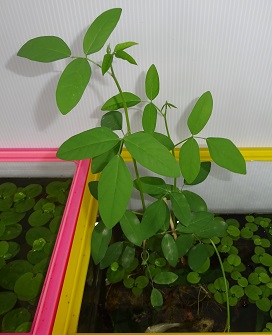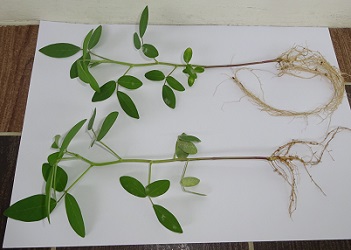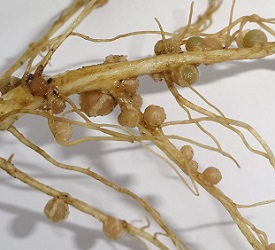| Home | Nature Weekly Index |
21 February 2016 | Phasey Bean's Root | Macroptilium lathyroides |
 The first time that I saw
Phasey Bean (Macroptilium lathyroides) was in August 2011
at a vacant land in Sembawang area. The land was cleared 2 years back for construction of housing flats. The plants in
the wild was observed to be erected with more elongated leaves. I was not aware that it was a climber then until I took
some seeds back and propagated them in my pots. It was a very dominant plant as compared to the rest of the plants in the
pots. Its demand for water was very high. In pots with sufficient water, the trifoliolate leaves were less elongated,
more of oval shape. It grew very fast and started bearing flower stalks within a few weeks when exposed to sufficient
sunlight. If not for the consistent infestation of the mealy bugs which I
shared on 6 April 2014, it would be a nice plant to have,
especially with its bright red flowers.
The first time that I saw
Phasey Bean (Macroptilium lathyroides) was in August 2011
at a vacant land in Sembawang area. The land was cleared 2 years back for construction of housing flats. The plants in
the wild was observed to be erected with more elongated leaves. I was not aware that it was a climber then until I took
some seeds back and propagated them in my pots. It was a very dominant plant as compared to the rest of the plants in the
pots. Its demand for water was very high. In pots with sufficient water, the trifoliolate leaves were less elongated,
more of oval shape. It grew very fast and started bearing flower stalks within a few weeks when exposed to sufficient
sunlight. If not for the consistent infestation of the mealy bugs which I
shared on 6 April 2014, it would be a nice plant to have,
especially with its bright red flowers.
I had stopped collecting its seeds from the plants in my pots and growing it. However, new plants continued to sprout from seeds that were dispersed randomly in the past few years. When the seed pods are ripe, they twist in a fast motion that flung the seeds in different directions.
Being a legume or bean plant, it is able convert atmospheric nitrogen to more useful nitrogen compounds such as ammonium or nitrogen dioxide with the help of symbiotic bacteria called rhizobium (soil bacteria) in the nodules of its root systems. The process of doing so has a scientific term --- nitrogen fixation. When the plant dies, these nitrogen compounds are released, making the nitrogen available to other plants, in a way helps to fertilize the soil. Nitrogen in the air is useless as most organisms do not have a mean to convert them to a compound that can be internalised to serve as building block of the organism.

 Earlier this month, I pull out two mid-size seedlings (about 20 centimetres tall) from my pot to investigate its root
system. Though I was aware of the presence of the root nodules, it still surprised me to see so many of them along the
roots. One of them which I pull out from a different had significantly few nodules when compared to the first one. The
variation probably had to do with the soil condition in the 2 different pots.
Earlier this month, I pull out two mid-size seedlings (about 20 centimetres tall) from my pot to investigate its root
system. Though I was aware of the presence of the root nodules, it still surprised me to see so many of them along the
roots. One of them which I pull out from a different had significantly few nodules when compared to the first one. The
variation probably had to do with the soil condition in the 2 different pots.
I read that this plant is tolerant of flood. Since throwing them away would be a waste, I secured them on a satay stick and anchored them in my mini aquarium. This was done on 9 February. As of today, both plants were still surviving while the fishes enjoying the additional hideout provided by the root system.